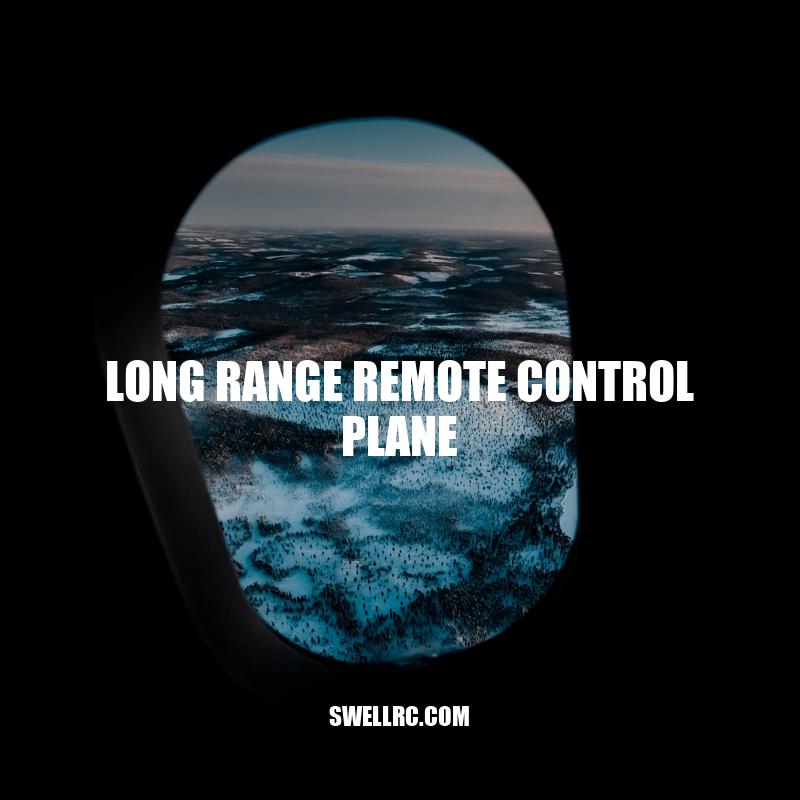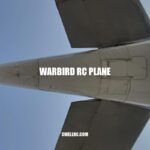Exploring Long Range Remote Control Planes: Facts and Uses
Long range remote control planes, or RC planes, have become increasingly popular among aviation enthusiasts and professionals. These planes are essentially a type of UAV (Unmanned Aerial Vehicle) that can be controlled remotely from the ground. Unlike regular RC planes that have limited range, long range RC planes can fly for extended periods of time over great distances, making them ideal for a wide range of applications. Aerial surveying, wildlife monitoring, search and rescue operations, and military reconnaissance are just a few examples of the uses of these planes. Long range RC planes are also used as a recreational hobby, with enthusiasts investing a significant amount of time and money into building and modifying their planes to achieve longer flight times and greater range. These planes are not your typical off-the-shelf RC toy; they require a level of knowledge and expertise to build and operate effectively. With advancements in technology and increased interest in the field of UAVs, the potential for long range RC planes to revolutionize the aviation industry is immense.
Types of Long Range RC Planes
Long range RC planes come in different shapes and sizes to suit various applications. Here are some common types of these planes in the market:
- Fixed-wing UAVs: These are the most common type of long range RC planes and resemble traditional airplanes. They have the advantage of higher speeds and longer flight times, making them ideal for applications requiring efficiency, such as aerial surveying, mapping, and search and rescue operations.
- Rotary-wing UAVs: These planes have a vertical takeoff and landing (VTOL) capability and resemble multirotor drones, such as quadcopters. They have greater maneuverability than fixed-wing UAVs, making them suitable for close-up aerial photography, inspection, and surveillance.
- Hybrid VTOL UAVs: These planes combine the advantages of fixed-wing and rotary-wing models. They can take off and land like rotary-wing UAVs and fly like fixed-wing UAVs. They are ideal for applications requiring flexibility in maneuverability, such as for military applications or for delivery services.
In addition, long range RC planes can be classified based on their payload capacity, flight range, flight endurance, and control mechanism. Some websites that offer long range RC planes include Horizon Hobby, Ready Made RC, and Amazon.com.
What are the advantages of hybrid VTOL UAVs compared to fixed-wing and rotary-wing UAVs?
Hybrid VTOL (Vertical Take-Off and Landing) UAVs have been gaining popularity due to their exceptional advantages over fixed-wing and rotary-wing UAVs. These advantages not only increase the overall mission capability of the UAV but also improve its efficiency and functionality.
Firstly, hybrid VTOL UAVs are capable of vertical take-off and landing which eliminates the need for runways or landing strips. Fixed-wing and rotary-wing UAVs require runways or large, obstacle-free areas for take-off and landing, which can be limiting in certain environments. A hybrid VTOL UAV, on the other hand, can take off and land in a compact area, making it suitable for both indoor and outdoor environments.
Moreover, hybrid VTOL UAVs combine the advantages of both fixed-wing and rotary-wing UAVs. They are capable of hovering, which is an essential feature for close range inspections or surveillance, and they can also fly for longer distances and at higher speeds without the limitations of a rotary-wing UAV. This versatility makes hybrid VTOL UAVs suitable for a wide range of applications, including surveillance, search and rescue, aerial mapping, and cargo delivery.
Additionally, hybrid VTOL UAVs are generally more energy-efficient than their fixed-wing or rotary-wing counterparts. Fixed-wing UAVs require a constant forward motion to stay in the air, and rotary-wing UAVs require a lot of energy to keep their rotors spinning. Hybrid VTOL UAVs, on the other hand, can switch between different modes of flight, reducing energy consumption and ultimately increasing flight time.
In conclusion, the advantages of hybrid VTOL UAVs over fixed-wing and rotary-wing UAVs include their ability to take-off and land vertically, their versatility in both indoor and outdoor environments, their ability to combine the advantages of fixed-wing and rotary-wing UAVs, and their increased energy efficiency. These advantages make them a popular choice for a wide range of applications in modern-day industries.
Technical Aspects of Long Range RC Planes
Long range RC planes are equipped with advanced technical features that enable their long-distance flight capabilities and high performance. Some key technical features of these planes include:
- Flight Controller: This is the brain of the plane and controls its flight, stability, and performance. It consists of sensors, processors, and software that regulate the plane’s speed, direction, altitude, and orientation.
- GPS: GPS is used to provide precise location and navigation data to the plane. It enables the plane to follow predefined flight paths and return to designated locations autonomously
- Telemetry: This feature enables the plane to transmit real-time flight data, such as altitude, speed, battery level, and signal strength, to the operator or ground control station (GCS).
- Autopilot System: This is a software-based system that can automate key aspects of the plane’s flight, such as takeoff, landing, and mission-specific tasks. It enables the plane to operate remotely and autonomously without continuous human control.
Long range RC planes also have other features that enhance their safety, reliability, and performance, such as:
- Fail-Safe Mechanisms: These are safety systems designed to prevent the plane from crashing or getting lost in case of a malfunction or loss of signal.
- Redundancy Systems: These are backup systems that provide redundant functions, such as redundant power sources and control systems. They ensure that the plane can continue to operate safely even if one system fails.
It’s important to note that long range RC planes have certain legal restrictions and guidelines that operators must follow to ensure safety and compliance with local regulations. Some products that offer technical features for long range RC planes include autopilot systems from Drone Nerds and telemetry modules from mRobotics. The table below summarizes some technical features of common long range RC planes:
| Feature | Fixed-Wing UAV | Rotary-Wing UAV |
|---|---|---|
| Flight Time | Up to 4 hours | Up to 1 hour |
| Range | Up to 50 miles | Up to 10 miles |
| Payload Capacity | Up to 10 lbs | Up to 3 lbs |
What are the safety mechanisms for long range RC planes?
Long range RC planes have become increasingly popular for hobbyists and enthusiasts, but safety is always a top concern. Fortunately, there are a variety of safety mechanisms in place to help prevent accidents and ensure a successful flight.
First and foremost, it’s important to choose a reliable and well-built RC plane. Look for models that have been extensively tested and come from reputable manufacturers. Additionally, make sure the plane is properly balanced and that all components are securely fastened.
One crucial safety mechanism is the fail-safe system. This system is built into the RC receiver and is designed to prevent the plane from flying out of range or losing signal. If the signal is lost, the fail-safe system will engage and automatically bring the plane back to a safe distance or land it altogether.
Another important safety feature is the GPS system. Many long range planes are equipped with GPS technology, which can help with navigation and ensure that the plane stays within safe boundaries. GPS technology can also be used to locate a lost plane in the event of a crash or malfunction.
Pilots should also take certain precautions to ensure safety. Always fly in a clear and open area, away from trees, buildings, and other obstructions. Make sure to fly during daylight hours and avoid flying in inclement weather conditions. And of course, always follow all local regulations and guidelines for RC aircraft.
Lastly, it’s important to have a backup plan in case of emergencies. Pilots should always carry extra batteries, tools, and spare parts in case of a malfunction or crash. Having a reliable support system, such as a fellow pilot or ground crew, can also provide additional safety measures and reassurance during flights.
Overall, long range RC planes can be safe and enjoyable to fly when equipped with proper safety mechanisms and flown responsibly.
Conclusion
In summary, long range remote control planes are gaining popularity among hobbyists, researchers, and professionals due to their ability to fly for longer distances and higher altitudes. These planes are equipped with advanced technical features such as GPS, flight controllers, telemetry, and autopilot systems that enable safe and efficient operation. Additionally, safety features like fail-safe mechanisms and redundancy systems further enhance the reliability of these planes.
Long range RC planes are used for various applications, ranging from aerial photography and surveillance to wildlife monitoring and search and rescue. They have a wide range of operations and can fly over difficult terrains that are inaccessible to other aircraft. With the increased demand for long range RC planes, more advanced technologies are being developed, leading to the possibilities of more exciting applications on the horizon.
However, it is important to note that long range RC planes must comply with local regulations and laws regarding their operation. Operators must keep in mind the safety of people, property, and the environment when using these planes.
In conclusion, long range remote control planes offer a thrilling and rewarding hobby as well as practical applications in various industries. With the right technical features, long flight times, and safety features, these planes can operate safely and efficiently, offering endless possibilities for users.



